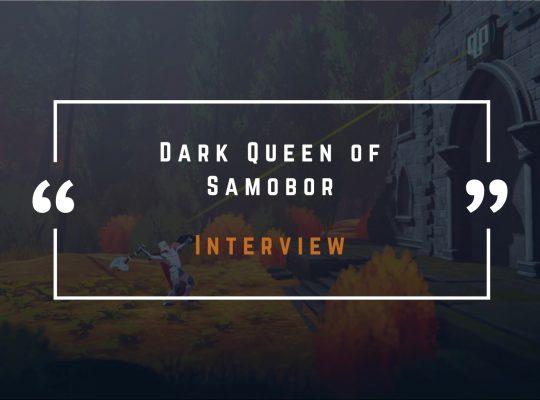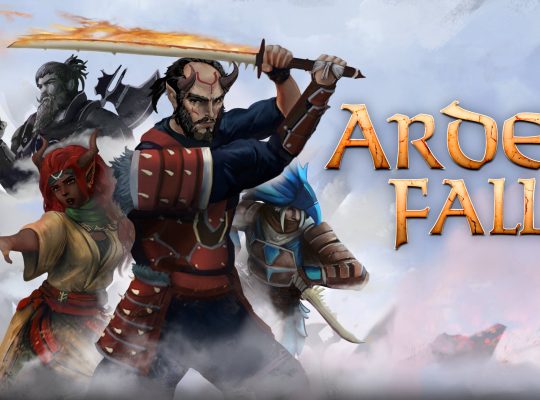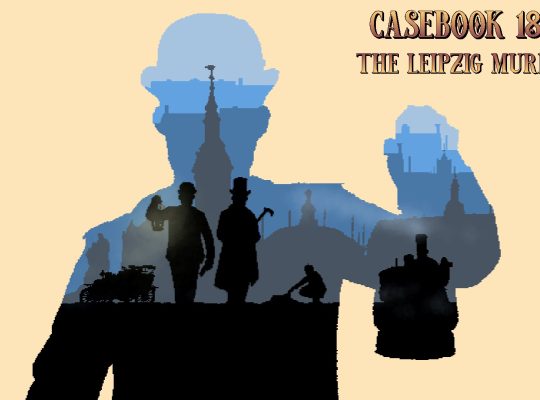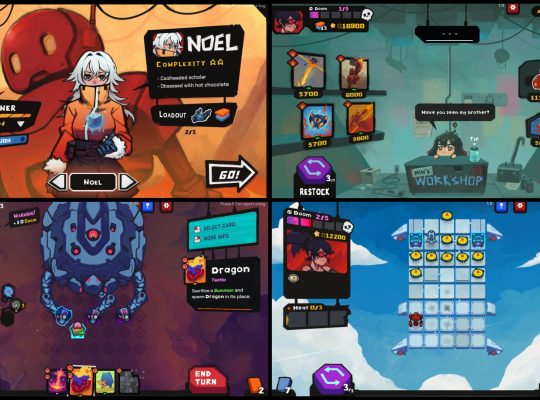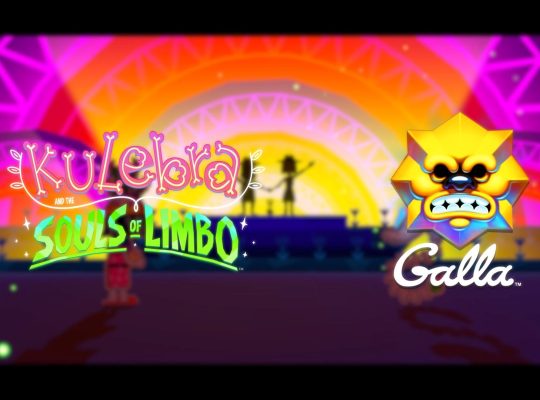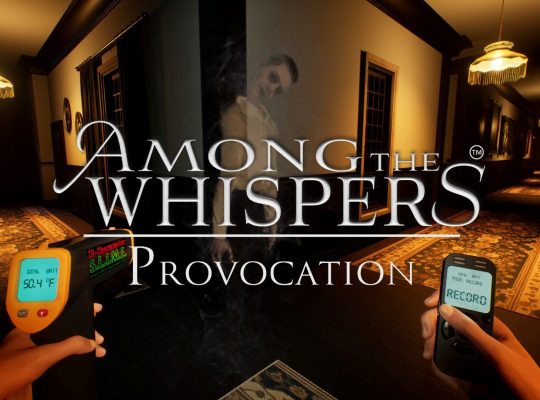Recently, we had the opportunity to interview the exceptionally talented studio Egobounds, where we spoke with Szymon Barciś, Jan Mutor, Piotr Woźnicki, and Krzysztof Woźnicki about their game Egging On. Besides joking about eggs, we delved deeper into the world of this game, learned what to expect, and why they decided to collaborate with the publisher Alibi Games.
This is a Polish studio whose first version of this game was created during PolyJam under the original title What Came First. Szymon is the level designer on this project and has been part of the team for a long time. Although he is educated on psychology, he became fascinated with level design and decided to dedicate himself to that field. Janek, on the other hand, works on creating assets and 3D graphics for Egging On. During the pandemic, he independently learned to work in Blender, which is now his main focus.
Piotr is involved in the style and artistic aspects of the game, as well as the technical details related to the graphics. As he says, "I have some experience in programming," but his main responsibility is visual consistency and the overall look of the game. Another important team member is Krzysztof, the lead programmer responsible for controller functionality, camera work, and the overall technical functioning of the game.
Egging On is a challenging climbing game that features realistic egg-based physics, inspired by titles like Getting Over It and Only Up!. Since its announcement in June 2024 during the Guerrilla Collective event, the game has gained significant attention, accumulating over 5 million views on social media and more than 25,000 wishlists on Steam.
Let’s start with the most important question: do you like eggs?
(Szymon): Yes, I eat eggs for breakfast almost every day. My favorite is a sandwich with a fried egg, where the yolk is still half-liquid. It’s been my favorite since my student days.
(Krzysztof): For me, the perfect egg is the one that’s exactly between soft-boiled and hard-boiled – the perfect balance. But I also like scrambled eggs.
(Jan): Funny enough, I haven’t eaten eggs for about four years. But when I did, I used to love fried eggs – super well-done ones, dry as a bone.
I ask because from the statistics overview of your first game Egging On, it is clear that players definitely love eggs – 5 million views on various social media. How do you feel about these results? Did you expect this level of popularity?
(Szymon): The IGN results from the content they made about us were the biggest surprise. Initially, we were shocked that they created a feature based on our Guerrilla Collective trailer, rather than just reposting our material. The numbers it reached were unexpected. Regarding wishlists, our principle is to create a high-quality game, so the more people express interest in it, the more it confirms our efforts.
(Jan): It’s cool that practically everyone loves eggs, so people naturally engage with the egg puns from the game. Even IGN made a „meme” in their reel, giving a dramatic echo to the sound of the egg cracking and transitioning into its “yolkstate,” which many people picked up on. It feels like the marketing is running itself.
(Szymon): Yes, even at PolyJam, people kept asking, “Can the egg break?” The curiosity around the egg triggers so many questions in people’s minds. Also, nobody can resist egg jokes, especially in English – swapping “ex” with “egg” is always funny. Seeing others enjoy this as much as we do is gratifying.
Where did the idea for a game about a rolling and jumping egg come from?
(Szymon): It was Krzysztof’s idea during PolyJam: to create a game about a rolling egg. Initially, it wasn’t fully jumping and climbing. The first version was more of a racing game where you’d race against a raw chicken from the fridge to the frying pan. Jumping was just one interaction back then; we focused more on the egg’s shape. Later, we wondered what would happen if the egg started climbing to great heights, like in Only Up!, Jump King, ALTF4, or Getting Over It. Then we incorporated egg-like traits – being fragile and delicate – which heightens the tension when climbing, as a falling egg is much more dramatic than a fall of rubber ball, a knight, or a man in a pot.




Since the egg can break so easily, will there be any checkpoints in the game? Or will players have to start over each time?
(Szymon): Currently, we have two approaches to checkpoints. The first is a “soft checkpoint” system: the player occasionally reaches safe spaces where they can’t fall much lower, making progress easier to maintain. We’re also considering an optional Assist Mode with “hard checkpoints.” Here, reaching a certain point saves your progress, allowing you to restart from that exact location. It’s a version for players who aren’t into the masochistic extremes of Dark Souls or classic climbers.
(Krzysztof): The main gameplay is hardcore, like other climbers, but we also wanted an option for players who might not feel confident in this genre.
How much time do you estimate it will take to complete Egging On?
(Szymon): In the default mode, around 16 hours. In assisted mode, probably about half that time.
(Krzysztof): Just like Getting Over It, which can be completed in under two minutes or even one, our game also makes that possible. Once someone masters it, they could finish in as little as 30 minutes.
(Szymon): Yes, the sequence in the chicken coop demonstrates this: players need about an hour to complete it for the first time, but after a few runs, they can do it in a minute. The map isn’t entirely linear, and there are shortcuts – either intentionally designed or discovered by players – to roll through and shorten the journey. This opens up a lot of possibilities for speedrunners and seasoned players to experiment and reduce their completion times.
You mentioned the chicken coop as one location. What other areas can players explore?
(Szymon): We have several main locations planned. First, the chicken coop and farm. Then, a processing plant, a store, a kitchen, and one more location we’re keeping under wraps. Each has its unique visual style and difficulty level, requiring a slightly different gameplay approach. These locations also have distinctive atmospheres enhanced by music and sound design – you can clearly feel the transition from the farm’s warm vibe to the cold, metallic processing plant.



Let’s talk about the process of creating Egging On. How long have you been working on this game?
(Szymon): The first PolyJam version was created in January this year. A few weeks after that, we met to plan the development of a full-fledged game. Over the following months, we worked on it – not always full-time, sometimes jus in the evenings – but always in full flow. Starting in July, we began working as a complete team, full-time, with additional people helping us with audio and narration. Before that, we weren’t fully committed due to needing to prepare promotional materials, set up the Steam page, record a trailer, arrange interviews, find a publisher, review contracts, etc. While we put time into the project, it didn’t directly translate into the game itself. Now, however, the vast majority of our work directly goes into the engine and the game itself.
Since this is your debut in the gaming industry, I’d like to ask: what was your biggest challenge?
(Szymon): Since it’s a game that requires precision from the player, the levels also had to be very interconnected. It’s not just about perfecting a specific section; everything has to connect well because you can fall back from one section to another. Designing a space that meets the difficulty requirements of the game was tough. Another challenge was realism – objects had to be properly scaled. If an object was too large for the egg to jump onto, we simply couldn’t use it. I think the more we work on this project, the faster we find solutions to these problems. However, finding those solutions for the first time was probably the most difficult part.
(Krzysztof): I think the biggest challenge was at the very beginning when we had to clarify the vision for this game. There were so many ideas that we eventually had to decide we wanted to make a climber game, giving more significance to the egg breaking. This also involved additional work with the camera because, in earlier versions, the camera was fixed from above and didn’t move. When we unlocked the camera’s movement and created a full 3D space, we faced the challenge of adapting camera work to this new environment.
(Piotr): I think one of the challenges is production planning itself – balancing the desire to polish something and the need to stay on schedule. It’s tough to strike that balance.
Technical and organizational issues aren’t easy to tackle, but on the flip side, what gave you the most joy while creating Egging On?
(Jan): I think creating Egging On is pure fun in itself. I feel I’ve been incredibly lucky with this project – we didn’t know each other before GameJam, but we clicked and shared a vision for this game. Personally, I enjoy creating the 3D models and graphics, and the fact that I get to do it full-time is amazing.
(Krzysztof): For me, the fun part is that making Egging On feels very similar to playing it – or playing Getting Over It, or any other game where you have to keep banging your head against the wall until you succeed. For example, I had many moments where the egg behaved strangely, and I finally figured out how to make it roll upright. That sense of achievement after many attempts is incredibly satisfying.
(Szymon): I get the most satisfaction from simply watching people play the game, seeing how they approach it, and how they discover new jumps. The same happens when we test things together – I hand over level fragments for testing, and we do our own speedruns, searching for the fastest paths and sharing tricks we discover within our game. That’s just amazing to me.




You’ve partnered with Alibi Games to publish the game. How do you assess your collaboration with this publisher so far?
(Szymon): It’s professional – both sides care about transparent communication. Their principle is to sign contracts only for games they genuinely love, and we can feel that in our collaboration. When we send them a new section of the game to play, they truly get excited and personally enjoy it. In this regard, we feel like one big team.
We don't yet have information on Egging On's release date or its potential availability on consoles. Any comments on that?
(Krzysztof): At this moment, we can’t reveal any information about the release date. Regarding consoles, we also need to wait before making a decision.
(Jan): But we can invite everyone interested in the game to our Discord server. There you can track the game’s development progress, read news, and ask us questions.
(Szymon): We have channels for both feedback and playtests, which we plan to organize with Discord members. We also welcome player ideas for what they’d like to see in the game, and Discord is the perfect space for exchanging these ideas.
Finally, is it okay to cry over spilled yolk?
(Szymon): It’s okay to cry, just as it’s okay to keep trying until you succeed.




